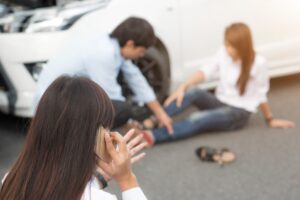Many car accidents happen when people drive negligently and violate traffic laws. The at-fault driver's insurance company pays your medical bills in many situations. However, at other times, you can turn to your personal injury protection (PIP) insurance coverage to pay medical expenses and lost income. Moreover, if the at-fault driver did not have insurance or was underinsured, you can file a UM/UIM claim with your insurance company for compensation. An experienced car accident attorney in your jurisdiction can explore available legal avenues of insurance coverage and work to recover the compensation you need for your medical expenses, both past and future, and other losses.
Common Car Accident Types and Causes
Car accidents vary, with several common types attributable to distinct causes:- Rear-end Collisions — One common type is the rear-end collision, often occurring when a driver fails to maintain a safe following distance or becomes distracted. In these situations, abrupt stops or unexpected slowdowns can lead to collisions.
- Intersection Accidents — Another common occurrence is the intersection accident, where drivers may disregard traffic signals or fail to yield the right-of-way. Such incidents often result from a lack of attentiveness or misjudgment of other drivers' actions. Failure to stop at a red light or stop sign is a common cause of many intersection accidents.
- Side-impact Collisions — Side-impact collisions, also known as T-bone accidents, frequently transpire at intersections when a driver fails to yield while making a turn. These accidents often result from misjudgment, speeding, or a lack of awareness of surrounding traffic conditions.
- Single-vehicle Accidents — Single-vehicle accidents are another noteworthy category involving only one vehicle. Factors such as slippery road conditions, distracted driving, or mechanical failures frequently contribute to this type of accident. Striking an obstacle, like a tree or guardrail, is a typical outcome in single-vehicle accidents.
- Rollover Accidents — Rollover accidents occur when a vehicle overturns onto its roof or side. Speeding and abrupt maneuvers can trigger rollovers, and high-profile vehicles, such as SUVs, are particularly susceptible. Additionally, adverse weather conditions and poorly maintained roads contribute to rollover accidents.
- Head-on Collisions — Head-on collisions, although less frequent, are often severe. They result from drivers crossing into oncoming traffic, commonly due to impaired driving, fatigue, or distraction. Failure to stay in the correct lane is a significant factor in these accidents.
- Parking Area Accidents — Crowded parking areas, distracted driving, failure to yield, and limited visibility contribute to collisions in these areas.
Types of Injuries That Lead to High Medical Bills in Car Accidents
Car accidents often result in a range of injuries that not only pose physical challenges but also bring about considerable medical expenses. Whiplash, a prevalent injury, occurs when the head forcefully jerks forward and backward, commonly in rear-end collisions. Although a soft tissue injury, whiplash can lead to chronic pain and necessitate extensive medical treatment, contributing to high medical bills. Traumatic brain injuries (TBIs) are another serious consequence of car accidents. The abrupt deceleration or impact can cause the brain to collide with the skull, resulting in varying degrees of injury. TBIs often require extensive medical interventions, including surgeries, rehabilitation, and long-term care, which contribute significantly to medical costs.
Spinal cord injuries, although less common, can be catastrophic. These injuries, often sustained in high-impact accidents, may lead to paralysis and require extensive medical attention, rehabilitation, and adaptive equipment, which contribute substantially to medical bills.
Bone fractures are also frequent in car accidents, affecting limbs, ribs, or other skeletal structures. Fractures can necessitate surgeries, prolonged hospital stays, and extensive rehabilitation, driving up medical expenses. The fracture's complexity and the need for specialized treatments further add to the financial burden.
Soft tissue injuries beyond whiplash include contusions, strains, and sprains. These injuries may seem less severe initially but can lead to lingering pain and require ongoing medical care, including physical therapy and medication. The cost of treating soft tissue injuries can accumulate over time, affecting an individual's financial well-being.
Internal injuries, such as organ damage or internal bleeding, can also result from car accidents. These injuries may not be immediately apparent, necessitating diagnostic procedures, surgeries, and ongoing medical monitoring. The comprehensive nature of treatment for internal injuries contributes significantly to the overall medical expenses.
The types of injuries resulting from car accidents are diverse and often lead to substantial medical costs. Whether it is whiplash, traumatic brain injuries, spinal cord injuries, bone fractures, soft tissue injuries, or internal injuries, the financial burden of medical treatment is significant and victims deserve compensation.
Traumatic brain injuries (TBIs) are another serious consequence of car accidents. The abrupt deceleration or impact can cause the brain to collide with the skull, resulting in varying degrees of injury. TBIs often require extensive medical interventions, including surgeries, rehabilitation, and long-term care, which contribute significantly to medical costs.
Spinal cord injuries, although less common, can be catastrophic. These injuries, often sustained in high-impact accidents, may lead to paralysis and require extensive medical attention, rehabilitation, and adaptive equipment, which contribute substantially to medical bills.
Bone fractures are also frequent in car accidents, affecting limbs, ribs, or other skeletal structures. Fractures can necessitate surgeries, prolonged hospital stays, and extensive rehabilitation, driving up medical expenses. The fracture's complexity and the need for specialized treatments further add to the financial burden.
Soft tissue injuries beyond whiplash include contusions, strains, and sprains. These injuries may seem less severe initially but can lead to lingering pain and require ongoing medical care, including physical therapy and medication. The cost of treating soft tissue injuries can accumulate over time, affecting an individual's financial well-being.
Internal injuries, such as organ damage or internal bleeding, can also result from car accidents. These injuries may not be immediately apparent, necessitating diagnostic procedures, surgeries, and ongoing medical monitoring. The comprehensive nature of treatment for internal injuries contributes significantly to the overall medical expenses.
The types of injuries resulting from car accidents are diverse and often lead to substantial medical costs. Whether it is whiplash, traumatic brain injuries, spinal cord injuries, bone fractures, soft tissue injuries, or internal injuries, the financial burden of medical treatment is significant and victims deserve compensation.
Proving a Third-party Negligence Claim After a Car Accident
Proving a third-party negligence claim after a car accident requires a strategic and thorough approach. Demonstrating four key elements: duty, breach of duty, causation, and damages is essential to establishing negligence. An experienced car accident attorney can handle the entire process for you and work diligently to successfully satisfy your legal burden of proof.- First, you must establish that the at-fault party owed you a duty of care. This duty is inherent in driving — all drivers must adhere to traffic laws and drive safely. Gathering evidence that illustrates the standard duty of care applicable to drivers in a jurisdiction is important.
- Next, you must demonstrate that the at-fault party breached their duty of care. This involves presenting evidence that shows the negligent actions or inactions of the other driver. For instance, if they violate traffic signals, fail to yield the right-of-way, or are distracted, these actions can be crucial in establishing a breach of duty.
- Causation is a pivotal element. You must establish a direct link between the at-fault party's breach of duty and the injuries or damages you sustained. Medical records, professional testimony, and accident reconstruction reports can establish this connection, providing a clear narrative of how the negligence led to the specific harm you suffered.
- Documenting damages is crucial in proving the financial and non-economic losses resulting from the accident. You must meticulously document medical bills, property damage assessments, lost income, and any other expenses related to the accident. Additionally, evidence of pain and suffering, emotional distress, or a diminished quality of life can contribute to the overall damages claim.
- Witness statements and any available surveillance footage can serve as valuable evidence to support your case. Eyewitness accounts can corroborate your events and provide additional perspectives on the at-fault party's actions. Surveillance footage, if available, can offer a visual representation of the accident sequence.
- Engaging expert witnesses, such as accident reconstruction specialists or medical or medical professionals, can strengthen your case. These professionals can provide authoritative opinions on the at-fault party's negligence, the mechanics of the accident, or the extent of your injuries, reinforcing the validity of your claim.
PIP Claims After a Car Accident and Payment of Medical Expenses
Personal Injury Protection (PIP) coverage is a form of auto insurance that provides coverage for medical expenses and lost income in the event of a car accident, regardless of who is at fault. PIP (or "no-fault") coverage enables individuals to receive benefits from their insurance company without establishing the other party's fault in the accident. Regarding medical expenses, PIP coverage typically covers a range of costs, including hospital bills, doctor visits, surgery, rehabilitation, and even funeral expenses in case of a fatality resulting from the accident. This coverage aims to ensure that individuals promptly receive necessary medical treatment without waiting for liability determinations. In addition to medical expenses, PIP provides coverage for lost income due to injuries sustained in an accident. Suppose the injured party cannot work during their recovery period. In that case, PIP compensates for a portion of their lost income, helping to alleviate the financial strain resulting from the inability to earn income. Remember to note that PIP coverage's specific terms and limits may vary depending on the insurance policy and state regulations. Understanding the details of your PIP coverage is crucial for ensuring you receive the necessary financial support for medical expenses and lost income in the aftermath of a car accident.Uninsured and Underinsured Motorist Claims Following a Car Crash
Uninsured and underinsured motorist claims are critical components of auto insurance coverage designed to protect individuals in the unfortunate event of an accident involving a driver without insurance or with insufficient coverage. Uninsured motorist (UM) coverage comes into play when an at-fault driver lacks insurance. Your insurance policy covers your medical expenses, property damage, and other potential losses in such situations. This coverage is crucial as it ensures that you have financial recourse if the at-fault party cannot cover the costs of the damages they caused. On the other hand, underinsured motorist (UIM) coverage applies when the at-fault driver has insurance, but their coverage is insufficient to fully compensate for your injuries or property damage. In this scenario, your underinsured motorist coverage differentiates between the at-fault driver's liability limits and your actual expenses. This type of coverage is valuable when the at-fault party's insurance falls short of covering your losses. When pursuing an uninsured or underinsured motorist claim, promptly notify your insurance company about the accident and provide the necessary documentation. This includes details of the accident, police reports, medical records, and evidence of the other driver's lack of insurance or insufficient coverage. In some cases, it may be necessary to take legal action against your insurance company to enforce your right to uninsured or underinsured motorist benefits. While these claims involve your insurer, remember that the insurance company's interests may differ from yours, and seeking legal advice can help navigate the complexities of the claims process. Understanding the nuances of uninsured and underinsured motorist coverage is vital for ensuring financial protection after an accident. By comprehensively assessing your insurance policy, promptly reporting incidents, and seeking legal guidance, you can navigate the claims process and secure the coverage you need when dealing with drivers who lack insurance or carry inadequate coverage.Additional Monetary Damages in Car Accident Cases
Car accident injuries can lead to various monetary damages beyond the immediate burden of medical bills. Past and future economic losses play a significant role in assessing the full financial repercussions of injuries resulting from another driver's negligence. Past monetary damages encompass various expenses already incurred due to the accident. These may include past medical bills, costs of rehabilitation, and expenses related to repairing or replacing damaged property, such as your vehicle. Also, lost income due to missed work during recovery contributes to past economic damages. Documenting these losses thoroughly is crucial when seeking compensation, as they provide a clear snapshot of the financial effects experienced in the aftermath of the accident.
Future economic damages anticipate the ongoing financial repercussions of the injuries sustained in the car accident. Projections may include anticipated medical expenses for continued treatments, surgeries, or rehabilitation. If the injuries lead to a reduced capacity to earn income, future lost income is part of the compensation as well. Adaptations to daily life, such as home modifications or the need for long-term care, also contribute to assessing future economic damages.
Non-economic damages play another significant role in compensating individuals for intangible losses. Pain, suffering, emotional distress, and diminished quality of life factor into the overall monetary compensation sought. Assigning a monetary value to these non-economic damages is often a complex process, considering the subjective nature of the accident on an individual's well-being.
Calculating monetary damages involves considering the circumstances surrounding the car accident and resulting injuries. Presenting a comprehensive case that accounts for both past and future economic losses, as well as non-economic damages, is crucial when seeking fair compensation. Engaging with legal professionals who focus on personal injury cases can provide valuable guidance in accurately assessing and presenting these damages to ensure that you receive appropriate compensation for the full financial repercussions of the car accident.
Past monetary damages encompass various expenses already incurred due to the accident. These may include past medical bills, costs of rehabilitation, and expenses related to repairing or replacing damaged property, such as your vehicle. Also, lost income due to missed work during recovery contributes to past economic damages. Documenting these losses thoroughly is crucial when seeking compensation, as they provide a clear snapshot of the financial effects experienced in the aftermath of the accident.
Future economic damages anticipate the ongoing financial repercussions of the injuries sustained in the car accident. Projections may include anticipated medical expenses for continued treatments, surgeries, or rehabilitation. If the injuries lead to a reduced capacity to earn income, future lost income is part of the compensation as well. Adaptations to daily life, such as home modifications or the need for long-term care, also contribute to assessing future economic damages.
Non-economic damages play another significant role in compensating individuals for intangible losses. Pain, suffering, emotional distress, and diminished quality of life factor into the overall monetary compensation sought. Assigning a monetary value to these non-economic damages is often a complex process, considering the subjective nature of the accident on an individual's well-being.
Calculating monetary damages involves considering the circumstances surrounding the car accident and resulting injuries. Presenting a comprehensive case that accounts for both past and future economic losses, as well as non-economic damages, is crucial when seeking fair compensation. Engaging with legal professionals who focus on personal injury cases can provide valuable guidance in accurately assessing and presenting these damages to ensure that you receive appropriate compensation for the full financial repercussions of the car accident.
Speak with a Car Accident Lawyer in Your Area Today

